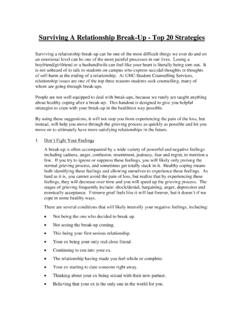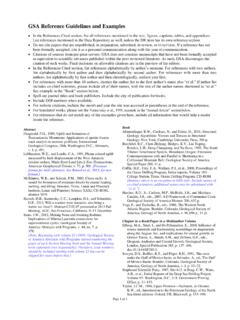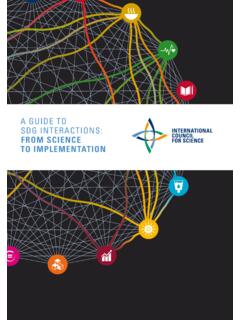Transcription of CSE Name-Year Citation Style Guide - McGill University
1 Prepared by Jan Sandink, Liaison Librarian Macdonald Campus Library, Aug. 2010; updated Jan. 2013 The CSE Citation Style : An Introduction It is important to cite the original source when using an idea, quotation, data, image, etc. that is not your own. Failing to cite your sources constitutes plagiarism. The Council of Science Editors (CSE) Style is a standard Citation Style used across many disciplines in the physical and life sciences. The CSE Style encompasses three distinct systems: Name-Year : In-text citations appear in brackets, and consist of the author(s) last name, as well as the document s year of publication ( Smith 2008). The end reference list appears in alphabetical order by author last name.
2 Citation -Sequence: A superscript number ( 1) is assigned to a document the first time it appears in the text, and the same number is used whenever that work is cited. The references in the reference list are listed numerically in the order in which they first appeared in the text. Citation -Name: All references in the reference list are organized alphabetically by author last name, and assigned a number according to their order in the list. This number is then inserted in the text in superscript font ( 1) wherever the work is cited. This Guide describes the Name-Year system only, and is based on Chapter 29 of the 7th edition of Scientific Style and Format: The CSE Manual for Authors, Editors, and Publishers, which is located in the reference section of both the Macdonald Campus Library (call number: T11 S386 2006) and the Life Sciences Library (call number: WZ 345 S416 2006).
3 For instructions on using the other two systems, or a more detailed description of the Name-Year system, please consult the Manual. PART 1: IN-TEXT CITATIONS The author s name and the year of publication are listed in parentheses at the end of the sentence: This claim was later refuted (Jones 2008). If the author s name is clearly mentioned in the text, it can be directly followed by the year of publication, in parentheses: Jones (2008) later refuted this claim. If both the author name and year are clearly mentioned in the text, there is no need to include a parenthetical reference : In 2008, Jones refuted this claim. If you are citing a specific part of a document ( a direct quotation, or a figure, chart or table), include the page number on which that information is found: These results clearly contradict those published in 2004 by the Smith lab.
4 (Jones 2008, p. 56). More than one author If a document has two authors, include both surnames separated by and . For works with three or more authors, include only the first author name, followed by et al. : .. (Andrews and Gray 1995).. (Gomez et al. 2003). Multiple works by different authors If you are citing several sources at once, list them in chronological order, or alphabetically if two or more works were published in the same year, and separate each one with a semicolon: .. (Samson 1963; Carter and Bowles 1975; Grimes 1975; Anderson et al. 1992). Multiple works by the same author published in the same year If you are citing two or more works written by the same author in the same year, add a designator (a, b, ) to distinguish them.
5 Use the same designators in the reference list: .. (Dubois 1976a; Dubois 1976b). Dubois J. 1976a. Detection of trends Dubois J. 1976b. Distribution patterns Citing a secondary or indirect source If you would like to cite a source that is cited in another document, it is always best to consult and then cite the original source. However, if you are unable to locate and verify the original source document, you must cite the secondary source while at the same time acknowledging the author of the original idea in both the in-text Citation and end reference : .. (Rawls 1971, cited in Brown 2008) CSE Name-Year Citation Style Guide Prepared by Jan Sandink, Liaison Librarian Macdonald Campus Library, Aug.
6 2010; updated Jan. 2013 Rawls J. 1971. A Theory of Justice. Cambridge (MA): Belknap Press. Cited in: Brown PG. 2008. The Commonwealth of Life: Economics for a Flourishing Earth. 2nd ed. Montreal (QC): Black Rose Books. Organizations as authors If the author of a document is an organization, corporation, government department, University , etc., use an abbreviated form of the organization in the in-text Citation , by retaining the first letter of each word in the name, or some other recognized abbreviation: .. (FAO 2006). PART 2: reference LIST The reference list comes at the end of your paper and includes full bibliographic information for all of the sources cited in the text. The references are listed in alphabetical order by first author last name.
7 Components of references in the reference list The following components, if available, are included when citing a source, in the following sequence: Books and other monographs Author(s) or Editor(s) Year of publication Title Content or medium designator Edition Secondary author(s) Place of Publication Publisher Pagination Series Journal and newspaper articles Author(s) Year of publication Article title Content or medium designator Journal or newspaper title Volume Issue Pagination Author(s) or Editor(s) List the last names and initials of the authors in the order in which they appear in the original document, and separate each one with a comma. Mary-Beth Macdonald and Laurence G. Kaufman become Macdonald MB, Kaufman LG.
8 If the document has editors rather than authors, follow the names with a comma and editor(s) : Macdonald MB, Kaufman LG, editors. More than ten authors Always include the names of the first ten authors. If there are more than ten, include the first ten author names only, followed by a comma and et al. Secondary author(s) Secondary authors include translators, illustrators, editors or producers, and may be included in the reference , in addition to the principal author(s), after the book title: Marquez GG. 1988. Love in the time of cholera. Grossman E, translator. New Organizations as authors ( ) The full name of the organization must be identified in the reference list, but preceded by the abbreviation used in the text, in square brackets.
9 Order the reference alphabetically by the full name, not the acronym: [FAO] Food and Agriculture Organization of the United Nations. 2006. Gender and law: Women s rights in Title Include both the title and subtitle, retaining the punctuation used in the original document. For books and journal article titles, capitalize only the first word, as well as proper nouns, acronyms and initials. All significant words in journal titles may be capitalized: Book: Plant cell culture: essential methods Journal: Canadian Journal of Animal Science Content designator Content designators describe the format of a document, and may be used to provide additional information with regards to the nature of a document ( dissertations, theses, bibliographies, and certain types of journal articles such as editorials, letters to the editor, news, etc.)
10 Content designators appear in square brackets directly after the title: Bernier MH. 2009. Assessing on-farm water use efficiency in southern Ontario [thesis]. Prepared by Jan Sandink, Liaison Librarian Macdonald Campus Library, Aug. 2010; updated Jan. 2013 Medium designator Medium designators indicate that the document is in a non-print format, such as microfiche , CD-ROM , or Internet . Medium designators are required and appear in square brackets directly after the title: Gooderham CB. 1917. Bee diseases [microfiche]. Place of Publication and Publisher The place of publication refers to the city where the publisher is located. This information is usually found on the title page of the book in question, or in the McGill catalogue record.













